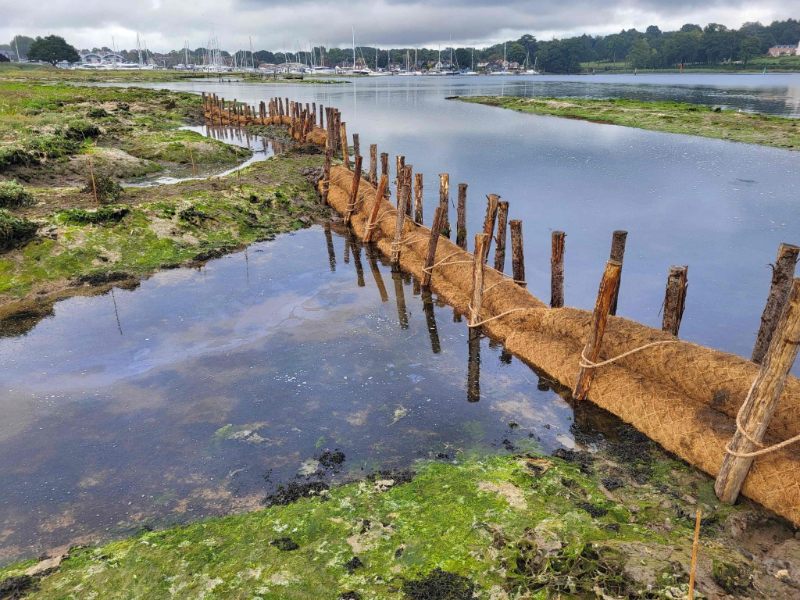Saltmarsh restoration is at the heart of our nature recovery projects here in Chichester Harbour; this precious habitat has declined by nearly 60% since 1946. A proud partner in the UN-endorsed Solent Seascape Project, last year we embarked upon an innovative trial to restore saltmarsh using sediment from routine dredging operations. With ambitious targets to restore 30% of the Solent’s Seascape, the project is science-led with a strong emphasis on partnership learning. And we are excited to learn from the latest saltmarsh restoration project over on the River Hamble.
Restoration on the River Hamble
In August, the Solent Seascape Project Team spent a week giving nature a helping-hand by undertaking the first stage of saltmarsh restoration trails at Hackett’s Marsh Nature Reserve on the River Hamble. In some of the hottest weather of the year, they worked on the water’s edge creating 12 creek barriers, with the aim of restoring the diminishing, but important habitat.
To achieve this, they hauled 107 three-metre-long coir rolls into place, knocked in over 330 chestnut stakes, and lashed it all together with over 400m of manila rope, creating over 107m of biodegradable barrier.
The work follows comparison of historic records dating back to 1870, which showed the creeks within the wildlife-rich marsh to be widening, decreasing the area of saltmarsh. The barriers are designed to trap sediment, stopping it from further washing away and allowing creeks within the marsh to return to the same level as the surrounding saltmarsh. This should eventually restore the threatened habitat, which is an important feeding area for waders and one of only two sites in Hampshire where unimproved pasture transitions to saltmarsh naturally, without seawalls or invasion by common reed.
Dr Luke Helmer, Restoration Science Manager at Blue Marine, who led the work, said,
“This is one of the most exciting elements of the whole Seascape Project for me. It has been gruelling work but an amazing team effort, coming together to restore saltmarsh and getting these barriers in. Now we wait patiently before starting phase two”.
Using knowledge gained from Essex Wildlife Trust’s saltmarsh work, Dr Luke Helmer and Professor Joanne Preston, from the University of Portsmouth, designed a system that is completely biodegradable and allows restoration to be potentially ‘fast-tracked’ in areas where large machinery and other methods can’t be used.
“No restoration work happens quickly, particularly saltmarsh, so I’m intrigued to see if we can accelerate this. I am optimistic that we will see some positive results over the next few years that might enable others to follow suit,” added Dr Helmer.
What next?
The second stage will test a novel approach. Following the discovery in Essex that saltmarsh plants establish extremely quickly on the coir barriers, coir matting will be placed over the sediment build-up within the creeks to help saltmarsh plants, such as glasswort, sea purslane, thrift and sea lavender, to establish more rapidly here as well. Some of these creeks will then be planted with ‘plugs’ of appropriate saltmarsh species. It is hoped that the root systems of the plants that establish will stabilise the sediment and a healthy marsh will once again inhabit the creeks.
Why restore saltmarsh?
A critical coastal habitat, saltmarsh provides many crucial benefits to the Solent area, including flood defence, increased wildlife, fish nurseries, improved water quality and carbon capture, but is in decline both nationally and locally, facing pressure from coastal development, sediment loss and rising sea levels. This is leading to a decrease in size, from which it is struggling to recover naturally. Its continued loss means urgent action is needed to reverse the rate and scale of decline.
What does this mean for Chichester Harbour?
The saltmarsh restoration work on the River Hamble represents a new approach, that could be replicated here in Chichester Harbour. We look forward to working with our Solent Seascape Project partners, sharing in their knowledge and learning to assess whether this approach may be taken here in the future.
East Head Impact and the Endangered Landscapes & Seascapes Programme (ELSP), managed by the Cambridge Conservation Initiative and funded by Arcadia, support the Solent Seascape Project. You can find out more about the Solent Seascape Project, follow their work and sign up for their newsletter here: www.solentseascape.com.
